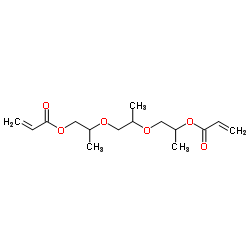Tri(propylene glycol) diacrylate

Tri(propylene glycol) diacrylate structure
|
Common Name | Tri(propylene glycol) diacrylate | ||
|---|---|---|---|---|
| CAS Number | 42978-66-5 | Molecular Weight | 300.348 | |
| Density | 1.0±0.1 g/cm3 | Boiling Point | 368.9±22.0 °C at 760 mmHg | |
| Molecular Formula | C15H24O6 | Melting Point | N/A | |
| MSDS | Chinese USA | Flash Point | 158.1±22.4 °C | |
| Symbol |


GHS07, GHS09 |
Signal Word | Warning | |
| Name | Tripropylene Glycol Diacrylate |
|---|---|
| Synonym | More Synonyms |
| Density | 1.0±0.1 g/cm3 |
|---|---|
| Boiling Point | 368.9±22.0 °C at 760 mmHg |
| Molecular Formula | C15H24O6 |
| Molecular Weight | 300.348 |
| Flash Point | 158.1±22.4 °C |
| Exact Mass | 300.157288 |
| PSA | 71.06000 |
| LogP | 1.75 |
| Vapour density | >1 (vs air) |
| Vapour Pressure | 0.0±0.8 mmHg at 25°C |
| Index of Refraction | 1.455 |
CHEMICAL IDENTIFICATION
HEALTH HAZARD DATAACUTE TOXICITY DATA
|
| Symbol |


GHS07, GHS09 |
|---|---|
| Signal Word | Warning |
| Hazard Statements | H315-H317-H319-H335-H411 |
| Precautionary Statements | P273-P280-P304 + P340 + P312-P333 + P313-P337 + P313-P391 |
| Personal Protective Equipment | Eyeshields;Faceshields;full-face respirator (US);Gloves;multi-purpose combination respirator cartridge (US);type ABEK (EN14387) respirator filter |
| Hazard Codes | Xi:Irritant;N:Dangerousfortheenvironment; |
| Risk Phrases | R36/37/38;R43;R51/53 |
| Safety Phrases | S24-S37-S61 |
| RIDADR | UN 3082 9/PG 3 |
| WGK Germany | 2 |
| RTECS | AT4690000 |
|
Electrochemical sensor for parabens based on molecular imprinting polymers with dual-templates.
Anal. Chim. Acta 673(2) , 145-50, (2010) A selective, sensitive, rapid and reliable method based on molecularly imprinted polymers (MIPs) with dual templates to determine total content of parabens in cosmetics was developed. With methylparab... |
|
|
A novel polyurethane-based root canal-obturation material and urethane-acrylate-based root canal sealer-part 2: evaluation of push-out bond strengths.
J. Endod. 34(5) , 594-8, (2008) We have developed a visible-light curable urethane-acrylate/tripropylene glycol diacrylate (UA/TPGDA) oligomer to serve as a root canal sealer and a zinc oxide/thermoplastic polyurethane (ZnO/TPU) com... |
|
|
Occupational dermatitis to ultraviolet-cured acrylic-based inks in computer hard disc manufacturing.
Am. J. Contact Dermatitis 9(3) , 179-81, (1998) Ultraviolet-cured acrylates and their various components and applications are reviewed in this report.A 26-year-old woman involved in silk screening computer discs with ultraviolet-cured inks develope... |
| 1-[(1-{[1-(Acryloyloxy)propan-2-yl]oxy}propan-2-yl)oxy]propan-2-yl acrylate |
| 2-{2-[2-(acryloyloxy)-1-methylethoxy]-1-methylethoxy}-1-methylethyl prop-2-enoate |
| UNII:VFM08CHC4D |
| 2-propenoic acid, 1-methyl-2-[1-methyl-2-[1-methyl-2-[(1-oxo-2-propenyl)oxy]ethoxy]ethoxy]ethyl ester |
| 1-[(1-{[1-(Acryloyloxy)-2-propanyl]oxy}-2-propanyl)oxy]-2-propanyl acrylate |
| 2-{2-[2-(acryloyloxy)-1-methylethoxy]-1-methylethoxy}-1-methylethyl acrylate |
| Tri(propylene glycol) diacrylate |
| EINECS 256-032-2 |
| 2-Propenoic acid, (1-methyl-1,2-ethanediyl)bis[oxy(methyl-2,1-ethanediyl)] ester |
| 2-Propenoic acid, 1-methyl-2-[1-methyl-2-[1-methyl-2-[(1-oxo-2-propen-1-yl)oxy]ethoxy]ethoxy]ethyl ester |
| tripropylene glycol diacrylate |
| MFCD00064598 |
| 1-[(1-{[1-(acryloyloxy)propan-2-yl]oxy}propan-2-yl)oxy]propan-2-yl prop-2-enoate |

